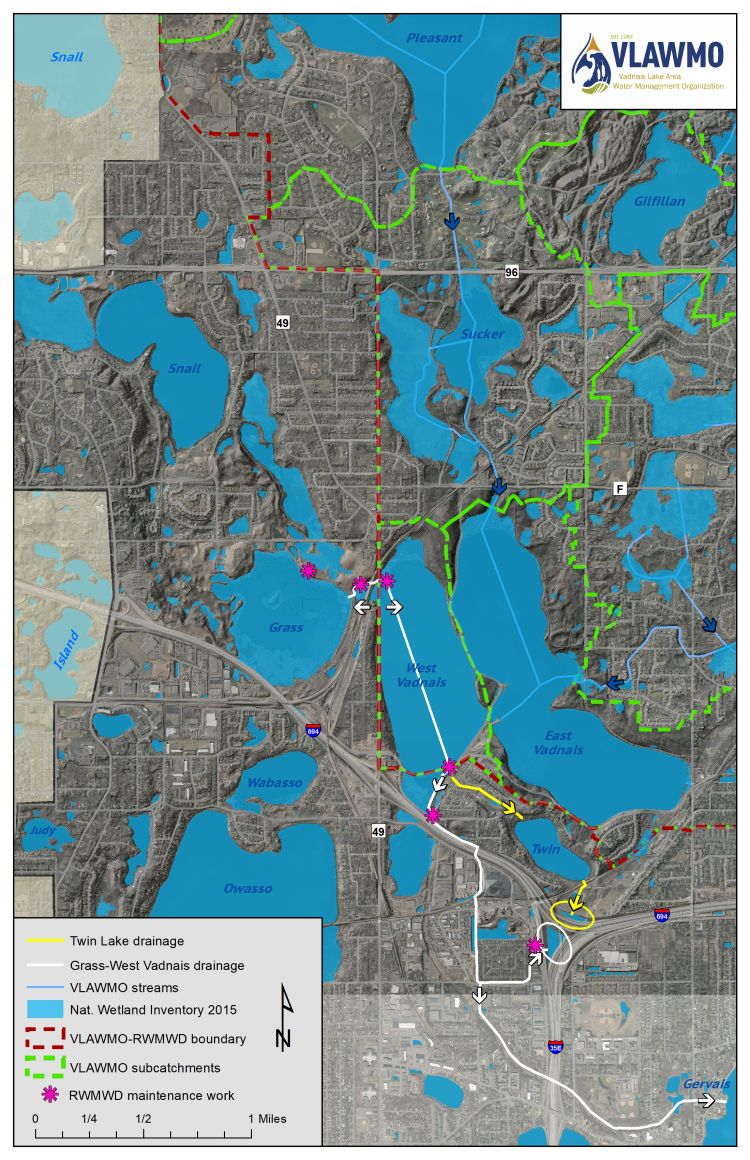West Vadnais & Rice Street Update
What’s the cause of the issue?
Snail and Grass Lakes are within the Ramsey Washington Metro Watershed District (RWMWD) and are experiencing extended high water levels and limited outflow. West Vadnais Lake is within the Vadnais Lake Area Water Management Organization (VLAWMO), but is unique in that it has culverts connecting it to Ramsey Washington Metro Watershed District on the north and south ends. Rice Street serves as a barrier between Grass Lake and West Vadnais, and unfortunately experiences much of the flooding and inconvenience to traffic. Looking at the causes of the issue, we must look to the trend of higher rainfall in recent years as well as landscape changes over the past few decades.
In the last 30-40 years, more impervious surfaces have been created in the metro (parking lots, rooftops, etc.), generating more water and faster flow into the lakes and wetlands of the area. Despite higher water volumes, the storage capacity in the lakes and wetlands has largely remained the same. Many areas in the metro are experiencing this tension between high water levels and need for storage, struggling to contain both large rain events and substantial spring snowmelt. In this, cities and counties realize that infrastructure and communities designed in the ‘70s and ‘80s weren’t planned for our present-day issues. VLAWMO is working toward identifying new solutions through partnerships, innovative infrastructure improvements, and a new outlook that seeks water storage opportunities in numerous, small spaces before larger issues arise.
- According to the Minnesota State Climatology Office, 2013-2018 has been the wettest six-year period on record.
- Over these six years, we have received an extra 30 inches of precipitation. This is equivalent to seven years of average rainfall within six years.
- This wet trend has continued throughout the early months of 2019. The MSP Airport weather station has reported the 8th wettest start to a year on record (January 1st to May 21th, 2019).
Next steps:
Various projects are being discussed and studied to pinpoint solutions between agencies. Options include:
- Increasing stormwater storage in West Vadnais by lowering the outlet under 694.
- Reviewing the overflow system both into and out of Twin Lake.
- Research flow capacity downstream of West Vadnais in the Gervais Creek and Phalen Lake systems.
- Raising the lowest area of Rice Street 4" between Grass and West Vadnais Lakes. Follow the Ramsey County website for news and updates on this project.
Be safe and informed when it comes to flooding. Do not swim, wade, or drive through flooded waters. Even shallow water can hide potholes or hazardous debris that should not be stepped on or driven over. While rushing floodwaters are less common in our watershed, don’t forget that these situations are possible and dangerous. Six inches of moving water is enough to knock a person over, and 12” is enough to sweep a vehicle away.
Follow the discussion or contribute at VLAWMO board meeting, or review minutes and agendas here.



